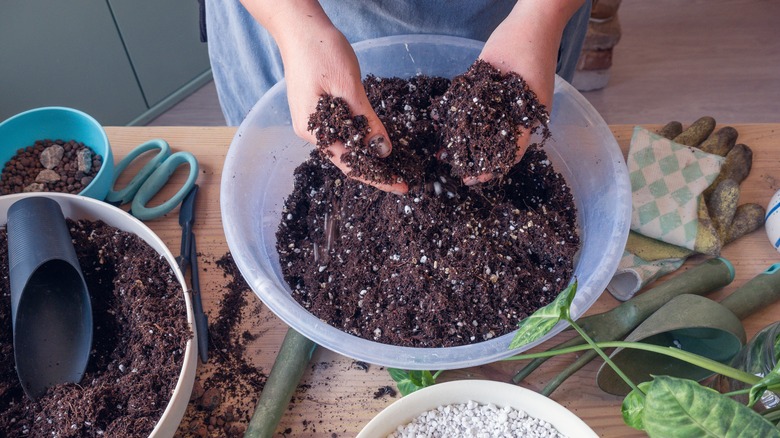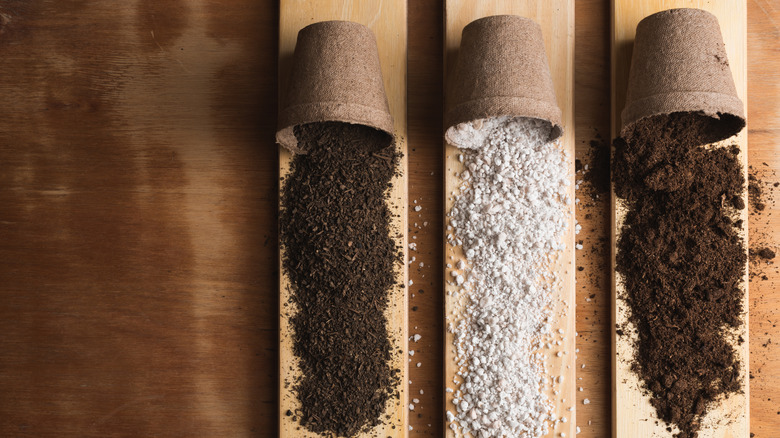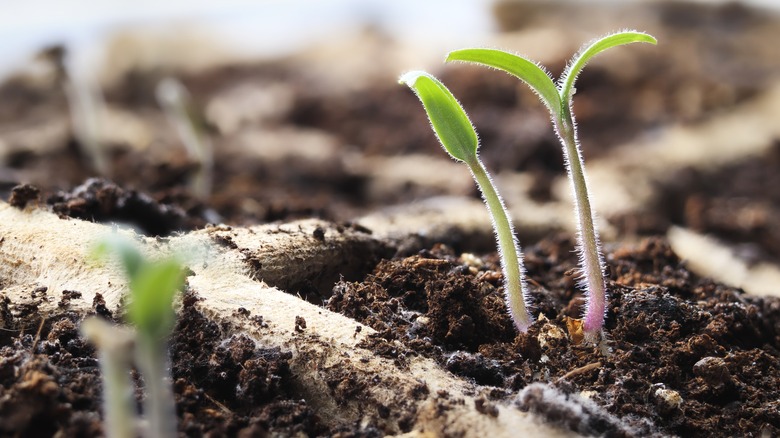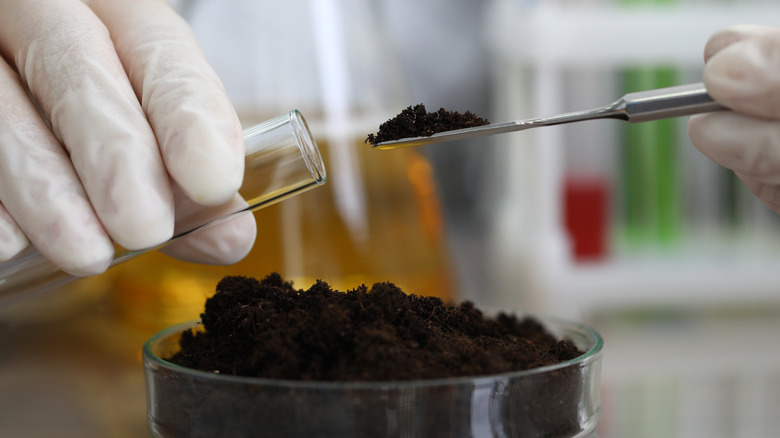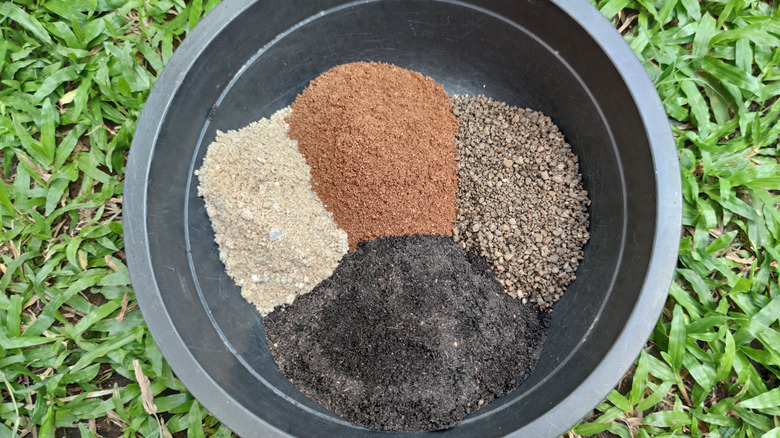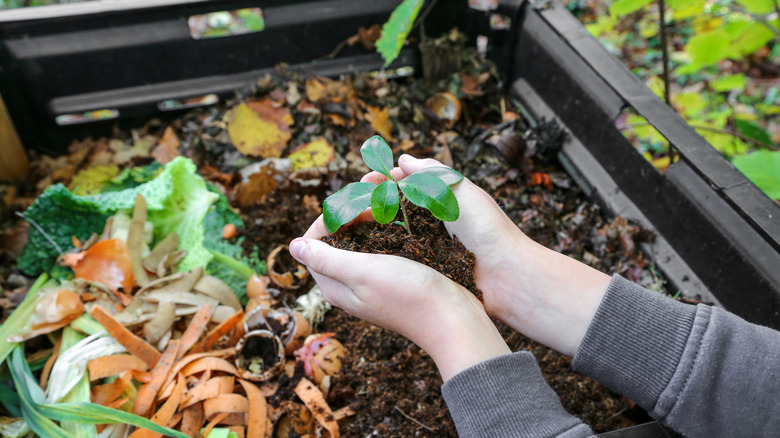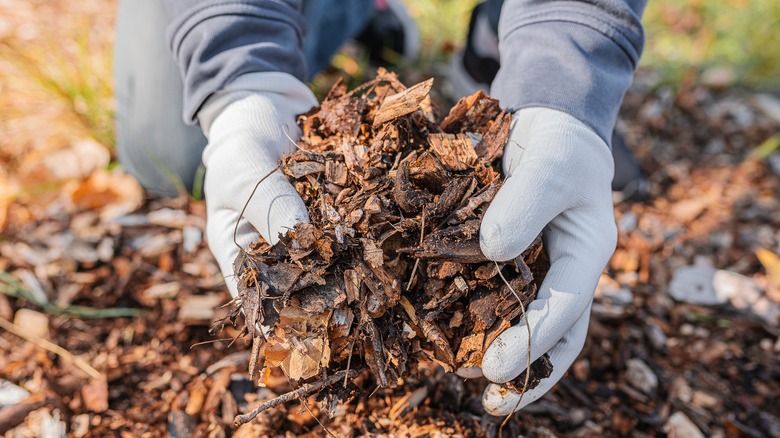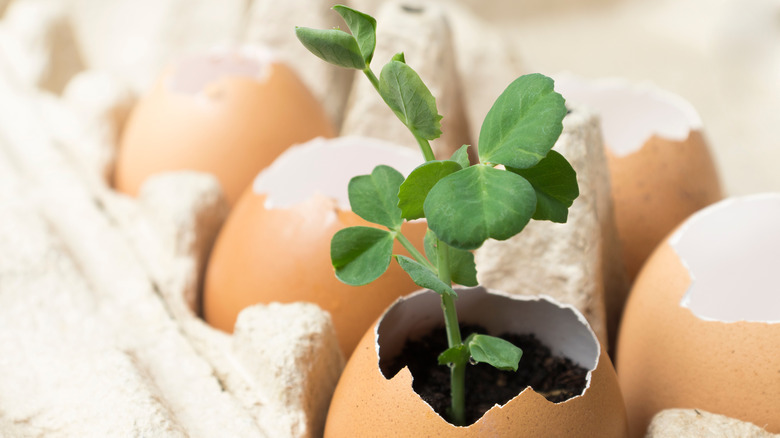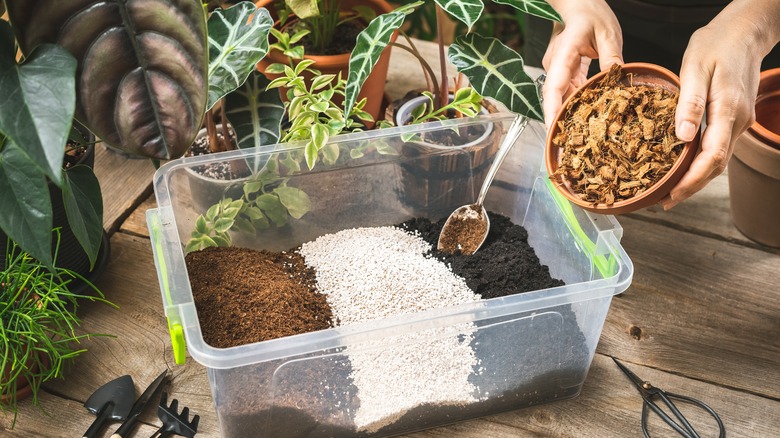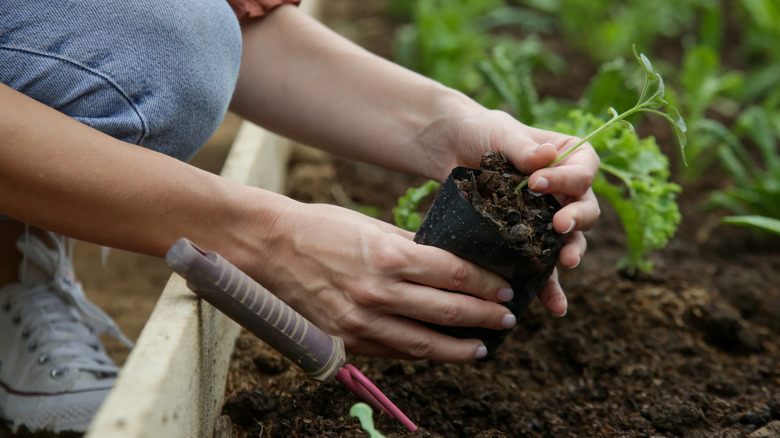Potting Soil Vs. Potting Mix: What's The Difference?
If the Sphinx had asked Oedipus about the difference between potting soil and potting mix, it might still be impossible to get into or out of Thebes. Experts claim it's simple, then fail to agree. (One website proclaims that potting soil is fine, so long as you never use it in a pot.) In the end, it seems to come down to sterility: Potting soil contains actual soil (that is, dirt from the ground) and is therefore likely to have not been sterilized, while potting mix is often sterile and therefore contains no pathogens. Which is confusing enough, but then you realize that sometimes potting mix is not sterile. Most seem to avoid this problem by using the terms completely interchangeably. The National Association of Gardeners is no help; its online dictionary includes neither term.
It's not unusual for labels to be misapplied, or applied inconsistently. Consider the term "organic" which, in this context, probably does not mean what you think it means. (We'll get to that.) When you're talking about potting soil, "organic" means simply that it's derived from living sources or processes. USDA regulations for the use of "organic" when referring to food do not apply here, even though just about everyone assumes they do (via Modern Farmer). Keep in mind, the chemical definition of "organic" doesn't mean much more than "contains carbon."
All of this is why gardeners tend to use biological nomenclature; they're not being uppity or pretentious, they're trying to avoid confusion by using scientific names for plants. Without anything that definitive to rely on, we'll have to dive into potting soils and mixes, and solve the mystery for ourselves.
Potting soil and mix basics
Assuming that potting soil or mix will be used in pots, it has a few unique characteristics (versus, say, garden soil). First, it must provide nutrients and hold them at your plant's roots. This is not a given for store-bought potting media, so read labels carefully and supplement with fertilizer as necessary, says Proven Winners. Second, potting media should retain moisture. Potting soil and mix tend to dry out quickly. You can mitigate this by choosing materials carefully (The Sill recommends ceramic containers for this purpose), but ultimately a soil amendment is a necessity for plant pots you won't constantly attend to.
Third, it has to be light enough to allow air to get to the roots. When gardeners say whacky stuff about plants that don't like to "get their feet wet," they're talking about this problem. Well-drained soil provides the aeration most plants require. Dense, wet soil will stunt or kill many plants, basically by suffocation. Finally, it has to manage this light airiness while being dense enough to provide support for plants' roots so they don't simply topple over.
Dirt, it turns out, does a lot of work.
Seed-starting mix & other formulations
Though it seems to be one of the few ways to tell potting mix from potting soil, there is some debate about whether potting mix should be sterile. This conflict might partly arise from confusion with seed-starting mix, which almost always is sterile, and often doesn't contain any substantial nutrients. Seedlings aren't great at resisting diseases, so keeping pathogens out of their germination medium is important. They also don't generally require nutrients until they're past the seed leaf stage. Since seed-starting mix occupies the space right next to potting mix, it's understandable if the sterility claims and rationales of the former get applied to the latter. But there's reason to not be over-concerned about the sterility of potting media. As Jennifer Kleffner of Miles Away Farm suggests, some of the pathogens are in the environment and are unavoidable in a home garden or greenhouse scenario.
Other forms of soil that you might stick in a pot also have characteristics that make it unsuitable for the purpose. These include garden soil, topsoil, straight manure or mulch, and cheap potting soils that don't meet the requirements for potting. Garden soil is prone to issues with moisture and aeration when removed to a pot. Topsoil shares these same issues, and might not have sufficient nutrients. Topsoil might be added to potting soil to provide stability and support to the plant (per Milogranite).
It is possible to grow many plants in straight compost or manure, depending on the physical properties and nutrient profile of the compost, but you're unlikely to get all four of the key components of potting media with unamended compost. Growing in straight mulch is a bad idea all around, and later we'll discuss what it does to the nutrient profile of your pot.
Soil composition
Looking at what soil itself (the stuff outside on the ground, or forming the ground) is instructive if you're trying to figure out what potting mix and potting soil should be doing. Basically, soil is a combination of some form of rock (gravel, sand, clay, etc.) and organic matter in one of its multitudinous forms, writes Proven Winners. Beyond that you might amend the soil to optimize it for your specific purposes.
The rock component of soil is mostly chemically inert (but see the note on CEC below) and provides structure to your soil. Sand leaves some room for air, while clay, with its much smaller particles, is denser and tends to hold on to water and nutrients, rather than having them pass through and away from plants' roots. Organic matter is a bit more interesting. In several ways it's about balance: balancing the nitrogen-hogging of wood chips and some mulch with nitrogen-rich manures; balancing large and small components for good soil structure; balancing materials that will break down quickly with those that will have more staying power. FreshFarm describes a simple experiment to analyze the basic contents of soil. Fill a tall, straight-sided glass jar halfway with soil, then add water to near the top. Stir well and wait for an hour or two and the soil will separate and stratify to show you the constituent parts of the soil: decomposing plant matter on top, followed by clay, silt, sand, and larger rocks.
Getting a handle on your soil's chemistry is, in part, about finding a couple of numbers: your soil's pH, which measures its acidity or alkalinity; its CEC (cation exchange capacity), a measure of the soil's fertilizer retention capacity; and electrical conductivity, which tells you how much fertilizer is present at the moment. Your local cooperative extension service can help you get and interpret a soil test.
Potting soil and potting mix composition
Potting soil is basically one of those optimizations of soil. Some amount of plain old soil is probably present, amended with stuff that improves those characteristics of helping with nutrients, moisture, air, and support. The differences between garden and potting soil are what drive the amendments. If you start with soil, you'll find that it probably needs more air for your plants' roots, which is where additions like sand, perlite, and vermiculite come in. And you'll almost certainly need to improve water retention with peat, coconut coir, and/or vermiculite, says Richard Hoyt of SFGATE. Compost might be tricky in pots and you might need to supplement with fertilizer.
The theory we're exploring here is that potting mix is basically potting soil without the dirt. You build it up, or buy it from someone who builds it up, from nothing with ingredients as you would with a recipe. Because (in our construction, at least) soil is generally omitted from potting mix, the whole thing is more airy... and therefore worse for support and, without further amendment, worse for retaining moisture. So what is the right mix?
Start with the base. Josh Steffen, Horticulture and Facilities Manager at Wellfield Botanic Gardens in Elkhart, Indiana, describes a career fixated on peat-based potting mixes, and then increasingly rejecting them for environmental reasons around sustainability and disappearing carbon sinks. There's some debate about this, and the ethics of the major alternative, coconut coir, are in question as well. Lisa Drewe's exhaustive "Coir: a Sustainability Assessment" suggests there are significant environmental, economic, and social issues with coir production (via Newleaf Natural Intelligence and, at least temporarily, the Internet Archive). These issues aside, both hold a lot of water and biodegrade slowly, recommending them as excellent media for potting plants.
Other ingredients in a potting mix include the same ones you find in potting soil. These (including alternatives to peat and coir) are discussed by Brian Barth in Modern Farmer.
Compost
When we talk about organic matter in soil or potting mixes, we're usually talking about some form of compost. In a landscape rather than a pot, we might further classify it as leaf mould, wood chips, mulch, manure, and so on, but in the end, they're all, functionally, compost. The question here is: Is compost properly understood as a component of potting mix? Or does its inevitable (and desirable) inclusion of microbes confine it to potting soil? You probably can't fertilize yourself out of the need for compost, so whether you mix it well in advance as a part of your potting mix or add it to the mix at the time of use, it's going to be part of the process.
A 2014 study published in Arboriculture & Urban Forestry Online examined the efficacy of compost versus wood chip mulch, inorganic fertilizer, aerated compost tea, a commercial biological product, and water (as a control). The conclusion was that wood chips and compost were the only alternatives that substantially improved soil quality. Wood chips aren't really viable for container gardening, as we'll discuss below, so that leaves compost as the ideal method for improving potting soils.
The problems with peat moss and wood chips
As we've seen, peat moss is a common ingredient in potting soils and mixes, and while it's generally useful, it has some significant problems that have caused many to turn to alternatives like coconut coir, rice hulls, and others. The environmental problems caused by the commercial harvest of peat might be a gray area, but peat's unfortunate habit of becoming hydrophobic if allowed to get too dry is a clear issue for potting mixes. In a nutshell, if you let peat dry out it will refuse to rehydrate easily without applying a wetting agent, according to Michigan SoilWorks. Of course, this is difficult to manage if the stuff is already in the soil.
Mulching has a lot of fans, but it doesn't come up much in the context of container gardening. This is partly because of the effect that mulch and wood chips have on the nutrient cycle, which makes it a poor solution for container gardening's moisture retention problems. Basically, the bacteria working to break down wood chips will temporarily tie up nitrogen. For long-term plantings where roots run deep, this isn't much of a concern, but it's not ideal for potted plants (via the Redding Record Searchlight).
Living potting soil
Ultimately, the question about what potting soil is versus potting mix requires you to decide if you're going to incorporate soil or compost into your mix, or attempt to keep it sterile (read: not alive) until the very last minute. Everyone agrees that soil is a collection of materials and living organisms. The process by which things decompose and re-enter the environment as nutrients is a story about intertwined lifecycles. But confronted with the possibility of importing plant diseases from previous uses, many seem to prefer a sterile medium, but this might not be ideal for healthy plants.
Soil can be depleted of nutrients, and while it's possible to supplement with fertilizers (this is how much of agriculture works), you'll get more complete plant nutrition with fewer chemical inputs by letting nature handle nutrients for you. But when "living soil" is discussed, it's usually in the context of garden soil: outside, on the ground. So the question is, does the soil testing and amendment process described by Bustling Nest apply in container gardening?
To the extent that living soil is more complete, it probably does. BuildASoil offers a living potting soil expressly for "water-only growers," which is probably how many people think of growing things in pots. But does the nutrient cycle actually happen in pots? The nutrient cycle is vast and varied, with processes ranging from clouds to bedrock and diverse inputs and actors (like microbes and insects) that you simply can't expect to sustain in a pot. What you can do is replace the soil periodically from living sources, but this is only better than fertilizing if you have a sustainable and nutrient-complete soil source, and don't mind a bunch of extra labor.
So, do you put soil in the pot?
DIY potting soil/mix
If you're homebrewing your potting medium, you can call it whatever you want, but a good place to start is recipes for potting mixes, and potting mix/soil is absolutely the kind of thing you can make for yourself, and probably drastically improve your outcomes in the bargain. To see what's involved, let's take a look at Cornell University's somewhat famous mixes, created for commercial growers and adapted by numerous people for home gardeners.
The typical Cornell mix is some combination of peat, vermiculite, perlite, super-phosphate and other commercial fertilizers and additives, Douglas fir bark, and a wetting agent. All or some of the peat can be replaced with coir, rice hulls, etc., thereby removing the need for the wetting agent. Planet Natural has an organic-focused version of Cornell's soil-less mix that is somewhat more complicated than the original: peat, compost, worm castings, chicken manure, vermiculite, Azomite, kelp meal, oyster shell flour, and an all-purpose fertilizer (these typically have N-P-K numbers that are all the same, like 10-10-10).
Where you go from there is a matter of personal experience, preference, and prejudice. Another Cornell effort in 2012 centered around on-farm trials gives some good advice: Watch high salt content when using manure-based compost. Avoid immature compost, which will promote damaging ammonia. Re-pot plants from seed-starting mix to a more nutrient-complete mix for growing. And use a good pH and EC meter to keep an eye on the actual state of affairs in your mix.
There's no shortage of potting mix recipes available online and, unlike the original Cornell versions, most don't measure ingredients in bushels or cubic yards.
So, what's the final verdict on soil, and soil versus mix?
The consensus is that a good potting medium for growing plants contains compost, which introduces many of the risks of contamination that come with soil. (Planet Natural has a good article about potting soil contamination, if you're curious.) It's a time-honored way of getting more complete nutrition for your plants, and you won't find many non-commercial growers who take issue with it.
By "growing plants" we mean plants that are beyond the seed-start phase. It's probably a good practice to start seedlings in a mix as close to sterile as possible, and the need for nutrients in a seed-starting mix is negligible. It might be impractical for a commercial farm to re-pot every seedling, but at home, it might be the best approach. When your plants pass the seed-leaf stage (or whatever is comparable for the given plant), transplant them to a potting mix.
Ultimately, the division between potting mix and potting soil is a matter of experimentation and refinement for the individual gardener. If you have consistently poor results with adding soil (or compost), then omit it and try again. The average mix probably benefits from soil more than from sterility, and this is quite obviously the natural state for plants. But this is also a matter of degree. Catastrophic pathogens obviously trump micronutrients, but trace amounts of heavy metals probably don't.
It's okay to preserve the distinction between potting mix and soil, because there is a difference, if a fairly minor one. But just know that you're probably fighting a losing battle because word usage is determined by the users, and most people use the terms "potting soil" and "potting mix" interchangeably, and that seems to work just fine.
